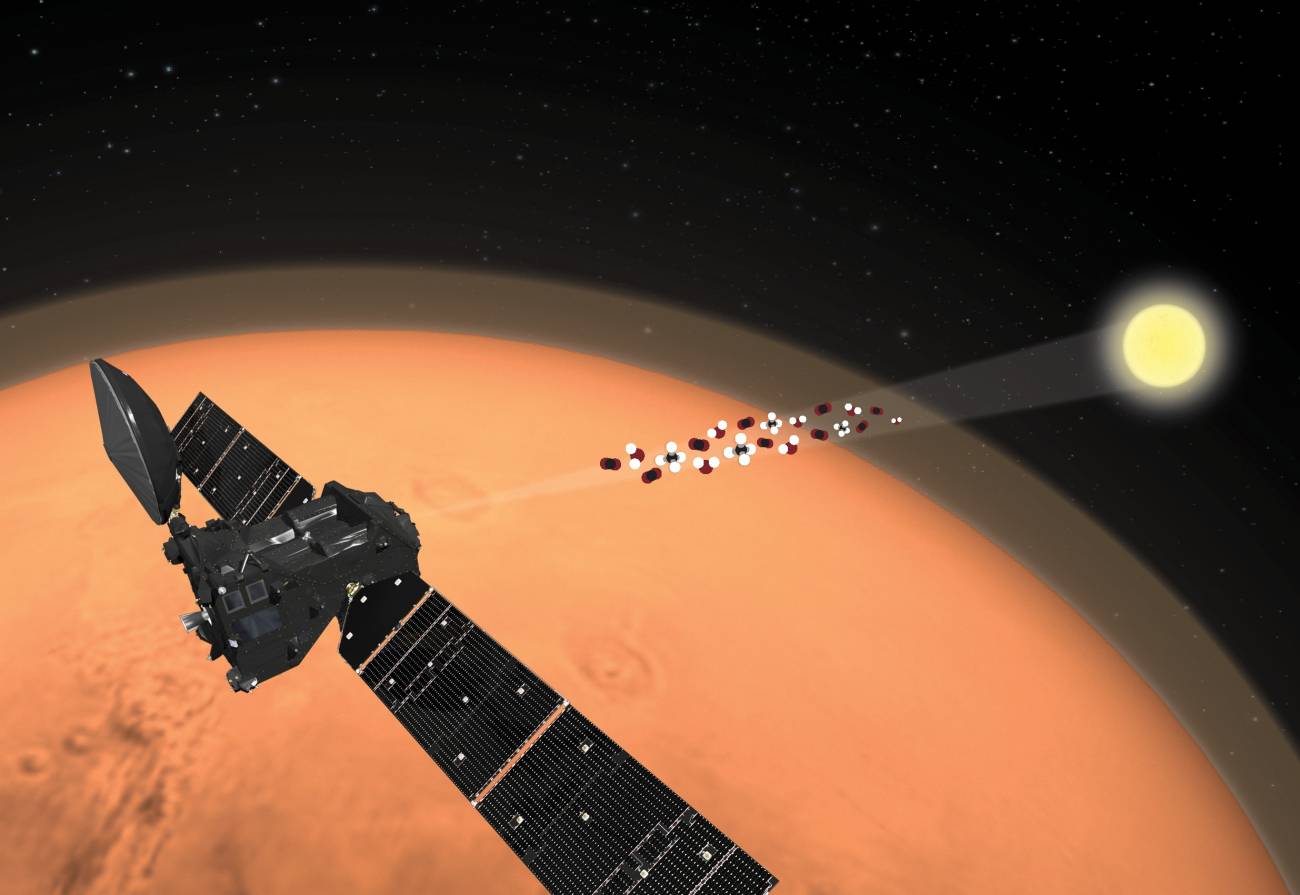Detection of the green line of oxygen in the atmosphere of Mars
NOMAD instrument, aboard the ExoMars (ESA) mission in orbit around Mars, has detected this diurnal emission of atmospheric oxygen for the first time outside Earth. The green line provides information on the composition and dynamics of the atmosphere, and this detection has also allowed to resolve a controversy between atmospheric measurements on land and atomic calculations
Atmospheric airglow is a natural phenomenon of our atmosphere, resulting from the interaction between sunlight and the atoms that make it up. Depending on the compound involved, light is emitted at different wavelengths, one of the most intense being due to the excitation of oxygen atoms, which provide the greenish tone of the polar auroras and produce a green line on the planet observable at night from space. The emission of oxygen during the day is more elusive, as it competes with sunlight, and has never before been observed on other planets. Thanks to the modification of the orientation of the NOMAD instrument aboard the TGO-ExoMars (ESA) mission, it has been detected for the first time in the atmosphere of Mars.
“The discovery of the presence of the green line of atomic oxygen in the atmosphere of Mars opens a window for the study of the behavior and photochemistry of this planet, and its study provides us with a tool to understand the interaction of solar radiation with the Martian atmosphere”, says José Juan López-Moreno, researcher at the Institute of Astrophysics of Andalusia (IAA-CSIC) who participates in the finding.

The detection required changing the orientation of the NOMAD instrument, on board the Trace Gas Orbiter (TGO-ExoMars / ESA) spacecraft, which has been in orbit around the red planet since October 2016. NOMAD observes, in the visible and in the ultraviolet, the illuminated face of Mars to measure the column of clouds, dust and ozone, but the change in orientation allowed it to observe the limb of the planet at different altitudes and search for the daytime emission of oxygen.
And indeed, NOMAD detected two emission peaks produced by oxygen atoms, one brighter at about 80 kilometers high and the other weaker at about 120 kilometers. “It was expected, but difficult to observe. We have finally found it -says Miguel Ángel López-Valverde, researcher at the Institute of Astrophysics of Andalusia (IAA-CSIC) that participates in the finding-. And the good fit that we have achieved with a photochemical model reveals that our description of the mechanisms of excitation of atmospheric oxygen are correct in a very different environment than on Earth and, therefore, they are exportable to other worlds".

The researchers concluded that the green line in Mars's atmosphere is produced by photodissociation of carbon dioxide molecules, the most abundant element in the Martian atmosphere. Once these molecules are broken down into oxygen and carbon monoxide, the oxygen atoms interact with the ultraviolet radiation from the Sun and produce airglow in the green region of visible light and weaker emission in the ultraviolet.
"We have been able to quantify the relationship between visible and ultraviolet emissions from atomic oxygen. Until now, there was a strong discrepancy between the results obtained through atomic physics models and the measurements made, never simultaneously, of these two emissions on Earth, because the atmosphere allows the passage of visible radiation but hinders ultraviolet radiation. With NOMAD measuring from outside the atmosphere in both parts of the spectrum we have been able to measure the relationship of both emissions and thus confirm that the values that are closest to reality are those obtained by atomic physics models. Once again, space exploration has allowed us to solve problems that are otherwise unsolvable", says José Juan López-Moreno (IAA-CSIC).
The variation in intensity and height of the green line on Mars depends on the distribution of carbon dioxide in the atmosphere. NOMAD data will allow the remote detection of seasonal changes in carbon dioxide at a height of about 80 kilometers from the surface, a region of the atmosphere inaccessible with direct measures but which is essential to know when sending manned and unmanned missions.
“Furthermore, this may be of great interest for studying the atmospheres of planets in other solar systems and searching for signs of life. The oxygen airglow reveals the presence of this compound, which is very abundant on Earth due to photosynthesis. So if the green line on an exoplanet were much more intense than the emission we just discovered on Mars, comparable to or greater than the intensity observed on Earth, it could be an indirect indicator of some kind of life capable of carrying out some kind photosynthesis”, says Miguel Ángel López-Valverde (IAA-CSIC).
“Personally, on the eve of my retirement by age, this detection has been an award. My first research work, my bachelor thesis, focused on the study of this same emission in the Earth's atmosphere. Its discovery by the NOMAD instrument now on that of Mars is like a precious close in my investigative journey”, concludes José Juan López-Moreno (IAA-CSIC).
J.-C. Gerard et al. " Discovery of green line emission in the day airglow of Mars from NOMAD-TGO observations". Nature Astronomy (June 2020).
Instituto de Astrofísica de Andalucía (IAA-CSIC)
Unidad de Divulgación y Comunicación
Silbia López de Lacalle - sll[arroba]iaa.es - 958230532
http://www.iaa.es
http://www-divulgacion.iaa.es

